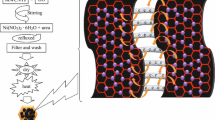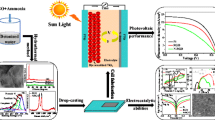Abstract
Dye-sensitized solar cells (DSSCs) are the most promising photovoltaic technology compared to other third-generation solar cells in terms of stability and cost-effectiveness. DSSCs involve the use of platinum-modified conductive glass substrate such as fluorine-doped tin oxide (FTO) as counter electrode material. Thus, to further reduce the cost of DSSCs, it is required to develop the Pt-free materials and use them as cost-effective counter electrode material for DSSC applications. In the present work, we have fabricated a nitrogen-doped reduced graphene oxide (N-rGO)-coated FTO glass substrates and employed it as counter electrode for DSSCs. The N-rGO/FTO counter electrode exhibited excellent electrocatalytic activity to catalyze the redox reaction. The N-rGO/FTO counter electrode-based DSSCs showed good efficiency of 6.7%. This shows that N-rGO/FTO may be a potential candidate for its use as counter electrode for the construction of DSSCs.






Similar content being viewed by others
References
Ahmad K, Ansari SN, Natarajan K, Mobin SM (2019) A two-step modified deposition method based (CH3NH3)3Bi2I9 perovskite: lead free, highly stable and enhanced photovoltaic performance. ChemElectroChem 6:1–8
Yue G, Lin JY, Tai SY, Xiao Y, Wu J (2012) A catalytic composite film of MoS2/graphene flake as a counter electrode for Pt-free dye-sensitized solar cells. Electrochim Acta 85:162–168
Ahmad K, Song G, Kim H (2022) Fabrication of tungsten oxide/graphene quantum dot (WO3@GQD) thin films on indium tin oxide-based glass and flexible substrates for the construction of electrochromic devices for smart window applications. ACS Sustain Chem Eng 10:11948–11957
Wang X, Zhao B, Kan W, Xie Y, Pan K (2022) Review on low-cost counter electrode materials for dye-sensitized solar cells: effective strategy to improve photovoltaic performance. Adv Mater Interfaces 9:2101229
Ahmad K, Shinde MA, Song G, Kim H (2021) Design and fabrication of MoSe2/WO3 thin films for the construction of electrochromic devices on indium tin oxide based glass and flexible substrates. Ceram Int 47:34297–34306
Wang H, Hu YH (2012) Graphene as a counter electrode material for dye-sensitized solar cells. Energy Environ Sci 5:8182–8188
Kumar P, Ahmad K, Dagar J, Unger E, Mobin SM (2021) Two-step deposition approach for lead free (NH4)3Sb2I9 perovskite solar cells with enhanced open circuit voltage and performance. ChemElectroChem 8:3150–3154
Ahmad K, Kumar P, Kim H, Mobin SM (2022) Optoelectronic and photovoltaic properties of (NH4)3Bi2I9: a perovskite-like energy material for Pb-free perovskite solar cells. ChemNanoMat 8:e202200061
Ahmad K, Khan MQ, Kim H (2022) Simulation and fabrication of all-inorganic antimony halide perovskite-like material based Pb-free perovskite solar cells. Opt Mater 128:112374
Ahmad K, Shinde MA, Kim H (2021) Molybdenum disulfide/reduced graphene oxide: progress in synthesis and electro-catalytic properties for electrochemical sensing and dye sensitized solar cells. Microchemical J 169:106583
Ahmad K, Kim H (2022) Enhanced stability of MAPbI3 based perovskite solar cells. Mater Lett 318:132187
Ahmad K, Khan MQ, Khan RA, Kim H (2022) Numerical simulation and fabrication of Pb-free perovskite solar cells (FTO/TiO2/Cs3Bi2I9/spiro-MeOTAD/Au). Opt Mater 128:112458
Ahmad K (2020) Bismuth halide perovskites for photovoltaic applications. In: Bismuth—fundamentals and optoelectronic applications. IntechOpen, London, UK
Mehmood U, Malik MI, Khan AH, Hussein IA, Harrabi K, Al-Ahmed A (2018) Effect of outdoor temperature on the power-conversion efficiency of newly synthesized organic photosensitizer based dye-sensitized solar cells. Mater Lett 220:222–225
Robinson K, Kumara GRA, Kumara RJGLR, Jayaweera EN, Rajapakse RMG (2018) SnO2/ZnO composite dye-sensitized solar cells with graphene-based counter electrodes. Organ Electron 56:159–162
Hosseinnezhad M, Rouhani S, Gharanjig K (2018) Extraction and application of natural pigments for fabrication of green dye-sensitized solar cells. Opto-Electron Rev 26:165–171
Chen T, Shang Y, Hao S, Tian L, Hou Y, Yang C (2018) Enhancement of dye sensitized solar cell efficiency through introducing concurrent upconversion/downconversion core/shell nanoparticles as spectral converters. Electrochim Acta 282:743–749
Mehrabian M, Dalir S (2018) Numerical simulation of highly efficient dye sensitized solar cell by replacing the liquid electrolyte with a semiconductor solid layer. Optik 169:214–223
Chen YC, Li YJ, Hsu YK (2018) Enhanced performance of ZnO-based dye-sensitized solar cells by glucose treatment. J Alloys Comp 748:382–389
Huaulmé Q, Cabau L, Demadrille R (2018) An important step toward more efficient and stable dye-sensitized solar cells. Chem 4:2267–2268
Iqbal MZ, Khan S (2018) Progress in the performance of dye sensitized solar cells by incorporating cost effective counter electrodes. Sol Energy 160:130–152
Atli A, Atilgan A, Yildiz A (2018) Multi-layered TiO2 photoanodes from different precursors of nanocrystals for dye-sensitized solar cells. Sol Energy 173:752–758
Kumar R, Bhargava P (2018) Synthesis and characterization of carbon based counter electrode for dye sensitized solar cells (DSSCs) using organic precursor 2–2′Bipyridine (Bpy) as a carbon material. J Alloys Comp 748:905–910
Paymozd F, Modarresi-Alam AR, Saravani H (2022) Synthesis and characterization of chiral nano-poly [(±)-2-sec-butyl aniline] and its application in the first chiral polymer solar cell. Opt Mater 125:112098
Singh M, Singh D, Pal P, Singh S, Singh D, Giri BS (2023) Synthesis and performance evaluation of Beta vulgaris based dye-sensitized organic solar cell. Environ Technol Innov 103220. https://doi.org/10.1016/j.eti.2023.103220
Tarique WB, Uddin A (2023) A review of progress and challenges in the research developments on organic solar cells. Mater Sci Semicond Process 163:107541
Bashir R, Bilal MK, Bashir A, Ali A (2023) Fabrication of PbSe colloidal quantum dot solar cells using low-temperature Li-doped ZnO electron transport layer. Sol Energy 256:67–75
Wang J, Peng Z, Huang J, Zhang Y, Zhang X, Wang Y, Fu Y, Li W, Chen J, Chen K (2023) Enhanced charge generation and transfer properties on anatase nanodendrite array photo-electrodes for high-efficiency quantum dot sensitized solar cells. Sol Energy Mater Sol Cells 257:112348
Khan U, Rauf A, Feng S, Akbar AR, Peng G, Zheng Q, Wu R, Khan M, Peng Z, Liu F (2023) Thermally stable and efficient CsF-doped all-inorganic CsPbIBr2 perovskite solar cells exceeding 15% PCE. Inorg Chem Commun 153:110862
Talebi H, Emami F (2023) High performance ultra-thin perovskite solar cell by surface plasmon polaritons and waveguide modes. Opti Laser Technol 165:109552
Song T, Zhang Z, Zhao B, Wang L, Kan W, Sun L, Wang X (2022) Boosting catalytic performance of hierarchical Co/Co0.85Se microspheres via Mott-Schottky effect toward triiodide reduction and alkaline hydrogen evolution. J Alloys Compd 918:165608
Liu Z, Xin W, Xie W, Wang X, Li N, Yuan Z, Li Y, Wang J (2022) Integration of hierarchical tin sulfide@sulfur-doped carbon porous composites with enhanced performance for triiodide reduction. Dyes Pigm 204:110458
Ahmad K, Mohammad A, Mobin SM (2017) Hydrothermally grown α-MnO2 nanorods as highly efficient low cost counter-electrode material for dye-sensitized solar cells and electrochemical sensing applications. Electrochim Acta 252:549–557
Wroblowa HS, Saunders A (1973) Flow-through electrodes: II. The I_3/I_ redox couple. Electroanal Chem Int Electrochem 42:329–346
Kay A, Gratzel M (1996) Low cost photovoltaic modules based on dye sensitized nanocrystalline titanium dioxide and carbon powder. Sol Energy Mater Sol Cells 144:99–117
Mirzaei M, Gholivand MB (2022) Synthesis of ruthenium sulfide nanoparticles decorated on reduced graphene oxide/multi-walled carbon nanotubes as a catalytic counter electrode for dye-sensitized solar cells exceeding 13% efficiency. Sol Energy 242:212–224
Akman E, Karapinar HS (2022) Electrochemically stable, cost-effective and facile produced selenium@activated carbon composite counter electrodes for dye-sensitized solar cells. Sol Energy 234:368–376
Suzuki K, Yamaguchi M, Kumagai M, Yanagida S (2003) Application of carbon nanotubes to counter electrodes of dye-sensitized solar cells. Chem Lett 32:28–29
Zhang DW, Li XD, Chen S, Tao F, Sun Z, Yin XJ, Huang SM (2010) Fabrication of double-walled carbon nanotube counter electrodes for dye-sensitized solar sells. J Solid State Electrochem 14:1541–1546
Novoselov KS, Geim AK, Morozov SV, Jiang D, Katsnelson MI, Grigorieva IV et al (2005) Two-dimensional gas massless dirac fermions in graphene. Nature 438:197–200
Geim AK (2009) Graphene: status and prospects. Science 324:1530–1534
Castro Neto AH, Guinea F, Peres NMR, Novoselov KS, Geim AK (2009) The electronic properties of graphene. Rev Mod Phys 81:109–162
Zhang DW, Li XD, Li HB, Chen S, Sun Z, Yin XJ, Huang SM (2011) Graphene-based counter electrode for dye-sensitized solar cells. Carbon 49:5382–5388
Bonaccorso F, Sun Z, Hasan T, Ferrari AC (2010) Graphene photonics and optoelectronics. Nat Photonics 4:611–622
Bae S, Kim H, Lee YB, Xu XF, Park JS, Zheng Y (2010) Roll-to roll production of 30-inch graphene films for transparent electrodes. Nat Nanotechnol 5:574–578
Wang X, Zhi L, Tsao N, Tomović Ž, Li J, Müllen K (2008) Transparent carbon films as electrodes in organic solar cells. Angew Chem Int Ed 47:2990–2992
Di CA, Wei D, Yu G, Liu Y, Guo Y, Zhu D (2008) Patterned graphene as source/drain electrodes for bottom-contact organic field-effect transistors. Adv Mater 20:3289–3293
Schedin F, Geim AK, Morozov SV, Hill EW, Blake P, Katsnelson MI et al (2007) Detection of individual gas molecules adsorbed on graphene. Nat Mater 6:652–655
Lee YH, Chou A, Yu J, Chen Y, Gooding JJ (2005) Demonstration of the advantages of using bamboo-like nanotubes for electrochemical biosensor applications compared with single walled carbon nanotubes. Electrochem Commun 7:1457–1462
Zhou M, He J, Wang L, Zhao S, Wang Q, Cui S, Qin X, Wang R (2018) Synthesis of carbonized-cellulose nanowhisker/FeS2@reduced graphene oxide composite for highly efficient counter electrodes in dye-sensitized solar cells. Sol Energy 166:71–79
Tasdemir A, Kopuklu BB, Kirlioglu AC, Gursel SA, Yurum A (2021) The influence of nitrogen doping on reduced graphene oxide as highly cyclable Li-ion battery anode with enhanced performance. Int J Hydrogen Energy 46:11865–11877
Wang G, Zhuo S, Xing W (2012) Graphene/polyaniline nanocomposite as counter electrode of dye-sensitized solar cells. Mater Lett 69:27–29
Lee KS, Lee Y, Lee JY, Ahn JH, Park JH (2012) Flexible and platinum-free dye-sensitized solar cells with conducting-polymer-coated graphene counter electrodes. Chemsuschem 5:379–382
Hong W, Xu Y, Lu G, Li C, Shi G (2008) Transparent graphene/PEDOT-PSS composite films as counter electrodes of dye-sensitized solar cells. Electrochem Commun 10:1555–1558
Choi H, Kim H, Hwang S, Choi W, Jeon M (2011) Dye-sensitized solar cells using graphene-based carbon nano composite as counter electrode. Sol Energy mater Sol Cells 95:323–325
Zhu G, Pan L, Lu T, Xu T, Sun Z (2011) Electrophoretic deposition of reduced graphene-carbon nanotubes composite films as counter electrodes of dye-sensitized solar cells. J Mater Chem 21:14869–14875
Dou YY, Li GR, Song J, Gao XP (2012) Nickel phosphide-embedded graphene as counter electrode for dye-sensitized solar cells. Phys Chem Chem Phys 14:1339–1342
Hou S, Cai X, Wu H, Yu X, Peng M, Yan K, Zou D (2013) Nitrogen-doped graphene for dye-sensitized solar cells and the role of nitrogen states in triiodide reduction. Energy Environ Sci 6:3356–3362
Wang G, Fang Y, Lin Y, Xing W, Zhuo S (2012) Nitrogen-doped graphene as transparent counter electrode for efficient dye-sensitized solar cells. Mater Res Bull 47:4252–4256
Xue Y, Liu J, Chen H, Wang R, Li D, Qu J, Dai L (2012) Nitrogen-doped graphene foams as metal-free counter electrodes in high-performance dye-sensitized solar cells. Angew Chem Int Ed 51:12124–12127
Salleh SA, Rahman MYA, Aziz THT (2022) Dye-sensitized solar cell using nickel sulfide-reduced graphene oxide counter electrode: effect of sulphur content. Inorg Chem Commun 135:109086
Acknowledgements
The authors extend their thanks to the Researchers Supporting Project (ref: RSPD2023R670), King Saud University, Riyadh, Saudi Arabia.
Author information
Authors and Affiliations
Corresponding author
Additional information
Publisher's Note
Springer Nature remains neutral with regard to jurisdictional claims in published maps and institutional affiliations.
Supplementary Information
Below is the link to the electronic supplementary material.
Rights and permissions
Springer Nature or its licensor (e.g. a society or other partner) holds exclusive rights to this article under a publishing agreement with the author(s) or other rightsholder(s); author self-archiving of the accepted manuscript version of this article is solely governed by the terms of such publishing agreement and applicable law.
About this article
Cite this article
Alharthi, F.A., Hasan, I. Synthesis of nitrogen-doped reduced graphene oxide as counter electrode material for dye-sensitized solar cells. J Solid State Electrochem 27, 3505–3512 (2023). https://doi.org/10.1007/s10008-023-05639-y
Received:
Revised:
Accepted:
Published:
Issue Date:
DOI: https://doi.org/10.1007/s10008-023-05639-y




